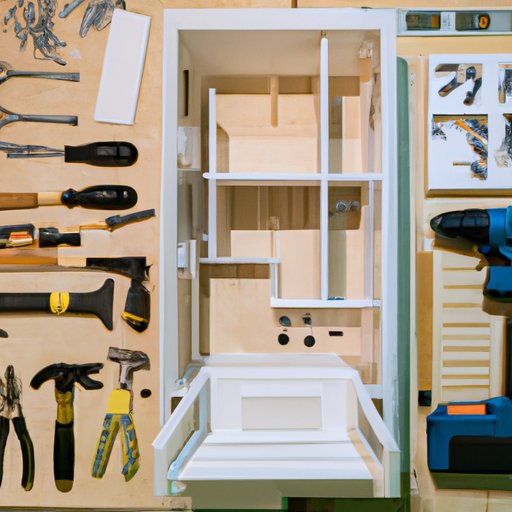
How to Build Cabinets: A Comprehensive Guide for DIY Enthusiasts
Building cabinets is a practical skill that can help you save money while also adding value to your home. Whether you want to add extra storage in your kitchen, bathroom, or home office, custom cabinets can fit your exact needs. In this article, we will provide a step-by-step guide, essential tools, pre-made templates, and customization options for building cabinets. This article is perfect for beginner DIY enthusiasts who want to learn how to build cabinets or more experienced builders looking for inspiration.
Step-by-Step Guide
Building cabinets requires patience, focus, and attention to detail. Here are the essential steps you need to follow:
Step 1: Measure and Cut Wood
Measure the size of the cabinet you want to build, and then cut plywood and hardwood to those measurements using a table saw or circular saw. Sand the edges to make them smooth and even.
Step 2: Build the Cabinet Box
Use wood glue and a nail gun to join the pieces together to create the main box structure. Make sure the corners are square and level using a carpenter’s square and a bubble level. You can also use pocket hole joinery to create a more secure structure.
Step 3: Install Shelves and Drawer Slides
Once the box is complete, measure and cut the shelves and then insert them into the cabinet. Install the drawer slides using a drill or a screwdriver. It’s essential to make sure that the drawer slides are level and mounted securely.
Step 4: Add Drawer Fronts and Doors
Measure the size of the drawers and doors and cut the plywood or hardwood that you will use as a front. Attach the front using a nail gun or screws. Sand and finish these pieces before attaching them to the cabinet.
Step 5: Finish the Cabinet
Sand and finish the cabinet using paint, stain, or varnish. Let dry, and your cabinet is ready to use.
Remember to break the steps down into smaller tasks to make the process more manageable. Before starting, ensure you have all the materials you need, including the right tools.
Video Tutorial
Watching a video tutorial is helpful when learning a new skill. Here are some helpful videos that showcase the cabinet-making process:
These videos provide a visual guide to help you understand the building process better. With a clear understanding of the steps, you can approach your cabinet-making project with confidence.
Pre-made Templates
If you don’t want to create a cabinet from scratch, you can use pre-made templates. Here are some resources to help you find templates or designs:
These resources offer customizable designs that can fit your specific needs. You can download or print the templates and follow the instructions to build a custom cabinet.
The Tools
Before embarking on a cabinet-making project, make sure you have the essential tools:
- Table Saw or Circular Saw
- Drill or Screwdriver
- Nail Gun and Nails
- Carpenter’s Square and Level
- Clamps and Wood Glue
- Sandpaper and Sanders
It’s essential to use these tools correctly to ensure a safe and successful project. You can source affordable tools through online retailers, local hardware stores, or borrow from a DIY-friendly neighbor.
Mistakes to Avoid
Here are some common mistakes to avoid when building a cabinet:
- Not Measuring Accurately
- Using the Wrong Materials
- Skipping Safety Precautions
- Not Properly Sanding and Finishing
- Ignoring Structural Integrity
Follow these tips to avoid these mistakes:
- Always measure twice and cut once.
- Choose high-quality materials that match your requirements.
- Ensure you wear proper safety gear, including gloves, glasses, and ear protection.
- Sand and finish the cabinet correctly to ensure durability.
- Stick to the plan and ensure the cabinet’s structure is stable and secure.
Customization
Customizing your cabinets can help you get the exact look and function you desire. Here are some ideas:
- Add More Shelves
- Install Pull-Out Drawers
- Change the Cabinet’s Dimensions
- Add Decorative Hardware
- Apply a Unique Finish
When customizing, it’s crucial to ensure that your changes don’t compromise the integrity of the cabinet’s structure.
Conclusion
Building cabinets is a practical and enjoyable DIY project that can add value to your space. We hope this guide has provided valuable insights into how to build cabinets. Remember to take your time, follow the steps, and take proper safety precautions. With patience and practice, you can create beautiful and functional cabinets that fit your specific needs.
If you need further inspiration or guidance, use the resources and pre-made templates mentioned in this article.




